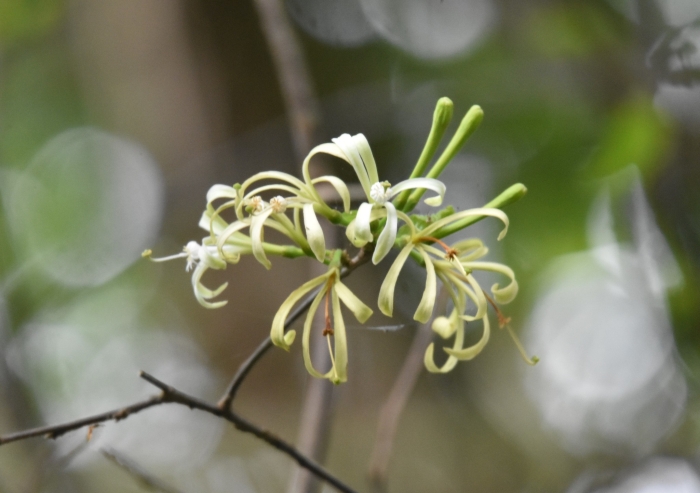Wild Honeysuckle Tree
(Turraea floribunda)
Wild Honeysuckle Tree (Turraea floribunda)
/
/

Justin Ponder
CC BY 4.0
Image By:
Justin Ponder
Recorded By:
Copyright:
CC BY 4.0
Copyright Notice:
Photo by: Justin Ponder | License Type: CC BY 4.0 | License URL: http://creativecommons.org/licenses/by/4.0/ | Rights Holder: Justin Ponder | Publisher: iNaturalist | Date Created: 2021-11-07T08:42:44-08:00 |

























Estimated Native Range
Summary
Turraea floribunda, commonly known as Wild Honeysuckle Tree, Forest Honeysuckle, Kakolokamumbu, Honeysuckle Tree, or Wild Gardenia, is a deciduous shrub or small tree native to the understory of tropical and subtropical forests across Africa. It thrives in a variety of habitats including coastal bush, forest margins, and open woodlands, usually on well-drained soil. Turraea floribunda typically grows to a height and width of 3-15 feet (0.9-4.6 meters), featuring a bushy habit with multiple stems and a rounded canopy.
The plant is noted for its glossy green leaves and its profusion of fragrant, white or cream flowers that bloom in the summer, attracting pollinators. The flowers are showy, with a trumpet-like shape that resembles that of true honeysuckle, although they are not related. After flowering, it may produce small, woody capsules containing seeds. In cultivation, Wild Honeysuckle Tree is valued for its ornamental flowers, ease of maintenance, and adaptability to a range of soil types. It is used in gardens as a specimen plant, for hedging, and in mixed borders. It prefers full sun to part shade and medium amounts of water, with a tolerance for medium or fast-draining loam or clay soils. While generally pest-free, it can occasionally suffer from leaf spot diseases or be affected by scale insects.CC BY-SA 4.0
The plant is noted for its glossy green leaves and its profusion of fragrant, white or cream flowers that bloom in the summer, attracting pollinators. The flowers are showy, with a trumpet-like shape that resembles that of true honeysuckle, although they are not related. After flowering, it may produce small, woody capsules containing seeds. In cultivation, Wild Honeysuckle Tree is valued for its ornamental flowers, ease of maintenance, and adaptability to a range of soil types. It is used in gardens as a specimen plant, for hedging, and in mixed borders. It prefers full sun to part shade and medium amounts of water, with a tolerance for medium or fast-draining loam or clay soils. While generally pest-free, it can occasionally suffer from leaf spot diseases or be affected by scale insects.CC BY-SA 4.0
Plant Description
- Plant Type: Shrub, Tree
- Height: 3-15 feet
- Width: 3-15 feet
- Growth Rate: Moderate
- Flower Color: White, Cream
- Flowering Season: Summer
- Leaf Retention: Deciduous
Growth Requirements
- Sun: Full Sun, Part Shade
- Water: Medium
- Drainage: Medium, Fast
Common Uses
Bird Garden, Butterfly Garden, Fragrant, Low Maintenance, Potted Plant, Showy Flowers
Natural Habitat
Understory of tropical and subtropical forests, coastal bush, forest margins, and open woodlands
Other Names
Common Names: Forest Honeysuckle, Kakolokamumbu, Honeysuckle Tree, Wild Gardenia
Scientific Names: , Turraea floribunda, Rutaea floribunda, Turraea heterophylla, Turraea kaessneri,
GBIF Accepted Name: